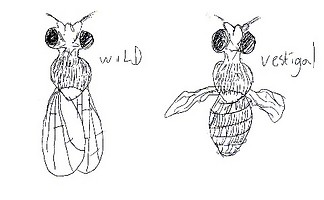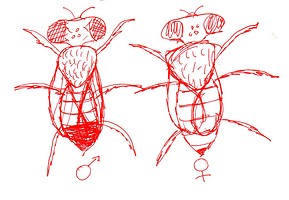Introduction
In my science class, we did a very interesting project on fruit flies. The reason why we picked fruit flies to work with is because they are the easiest species to use fly nap on. Our ideas and understandings were based on Mendel's experiments and principles on Genetics. Therefore the main idea is pretty much how characteristics are transmitted from parents to offspring. During the lab we kept track of mutations, vestigial wings and the wild. During class we gathered up in partners to nap the flies in a certain order. First we separated the females and the males, then we separated the ones with vestigial wings and separate those as females and males as well. Basically this project was about learning how scientists predict the genetics of fruit flies and other animals. The key for this data was Genotype and Phenotype. The genetic make-up of the fruit fly is the genotype and it's appearance is the phenotype.
Characteristics
The fruit fly is a member of the phylum Arthropoda and are arthropods. Like annelids, arthropods are segmented animals. The class is Insecta. They have one pair of wings (hind pair reduced to knobs) they have piercing, sucking, or rapping mouthparts.
Phenotypes
During our experiment with the fruit flies, we had to learn three different Phenotypes. There are three different Phenotypes. Wild type Drosophila, Recessive sex-linked white eyes, and Red eye vestigial wings.
Group Life Cycle Log
F1
3/16/06- one in each container died (a female and a male)F2
Sexing the Flies
The first step that we took was we used fly nap to anesthetize them so they would be easier to handle. When we were sexing the flies we had to look at the flies while they were on their backs so we could see if they had a darker abdomen or a lighter. When we found the males we put them on one side of a piece of paper and we put the females on the other.
F1 Predictions
We worked with four hypotheses that had either vestigial as dominant or as recessive. The first hypothesis was vestigial dominant and wild recessive. Our second hypothesis was wild dominant and vestigial recessive. We also had hypothesis that were sex-linked like our third, which was vestigial sex-linked and dominant and wild was recessive. The last one was wild type sex-linked and dominant and vestigial recessive.
Autosomal Hypothesis # 1 vestigial dominant
| vg | vg | |
| + | vg+ | vg+ |
| + | vg+ | vg+ |
Sex-linked Hypothesis #3 vestigial sex-inked and dominant
| x+ | y | |
| xvg | xvgx+ | xvgy |
| xvg | xvgx | xvgy |
We first predicted that the phenotype was 100% vestigial and the genotype was vg+, but in vial 1 there were no vestigial flies and in vial 2 there was a contamination. So our conclusion for the F1's were autosomal recessive.
F2 Predictions
For our F2 predictions we had two vials. In vial 1 we had wild males and females.
| + | vg | |
| + | ++ | +vg |
| vg | +vg | vgvg |
Vial 2
| vg | + | |
| + | vgvg | vg+ |
| vg | vg+ | ++ |
Fly Counts
Vial One
| Date F2 Counted | Female Wild | Male Wild | Female vg | Male vg |
| 4/9/06 | 9 | 8 | 8 | 7 |
| 4/21/06 | 19 | 16 | 0 | 3 |
| 4/24/06 | 53 | 39 | 16 | 6 |
| 4/25/06 | 18 | 8 | 0 | 5 |
| Overall Total | Total Female + | Total Male + | Total Female vg | Total Male vg |
| Total WIld | Total vestigial |
Vial Two
| Date F2 Counted | Female Wild | Male Wild | Female vg | Male vg |
| 4/9/06 | 36 | 34 | 22 | 22 |
| 4/21/06 | 32 | 30 | 6 | 4 |
| 4/24/06 | 7 | 6 | 15 | 12 |
| 4/25/06 | 0 | 2 | 0 | 0 |
| Overall Total | Total Female + | Total male+ | Total Female vg | Total Male vg |
| Total vestigial | Total Wild |
Percent Error
Vial 1
| Phenotype | observed | expected | O-E | O-E/E | X100 | %ERROR |
| vestigial | 45 | 53.75 | 8.75 | .1628 | 16.28 | 16.28% |
| wild | 170 | 161.25 | 8.75 | .0543 | 5.43 | 5.43% |
Vial 2
| Phenotype | observed | expected | O-E | O-E/E | X100 | %ERROR |
| vestigial | 81 | 57 | 25 | .4211 | 42.11 | 42.11% |
| wild | 147 | 171 | 24 | .1404 | 14.09 | 14.09& |
Conclusion
Our hypothesis was that, if the mutation vestigial is autosomal recessive in the P generation, then by the F2 generation the expected Phenotype Ratio is 75% wild : 25% vestigial. The Hypothesis was supported based on data and percent error. The only problem we had was that we had contamination in vial two which probably messed up some of our data. If we were to repeat this we would probably double check all of our work, like our punnett squares and our tables.
Eulogy
Life never ends, it just takes a left turn, R.I.P fruit flies








 Go to quick links
Go to quick search
Go to navigation for this section of the ToL site
Go to detailed links for the ToL site
Go to quick links
Go to quick search
Go to navigation for this section of the ToL site
Go to detailed links for the ToL site